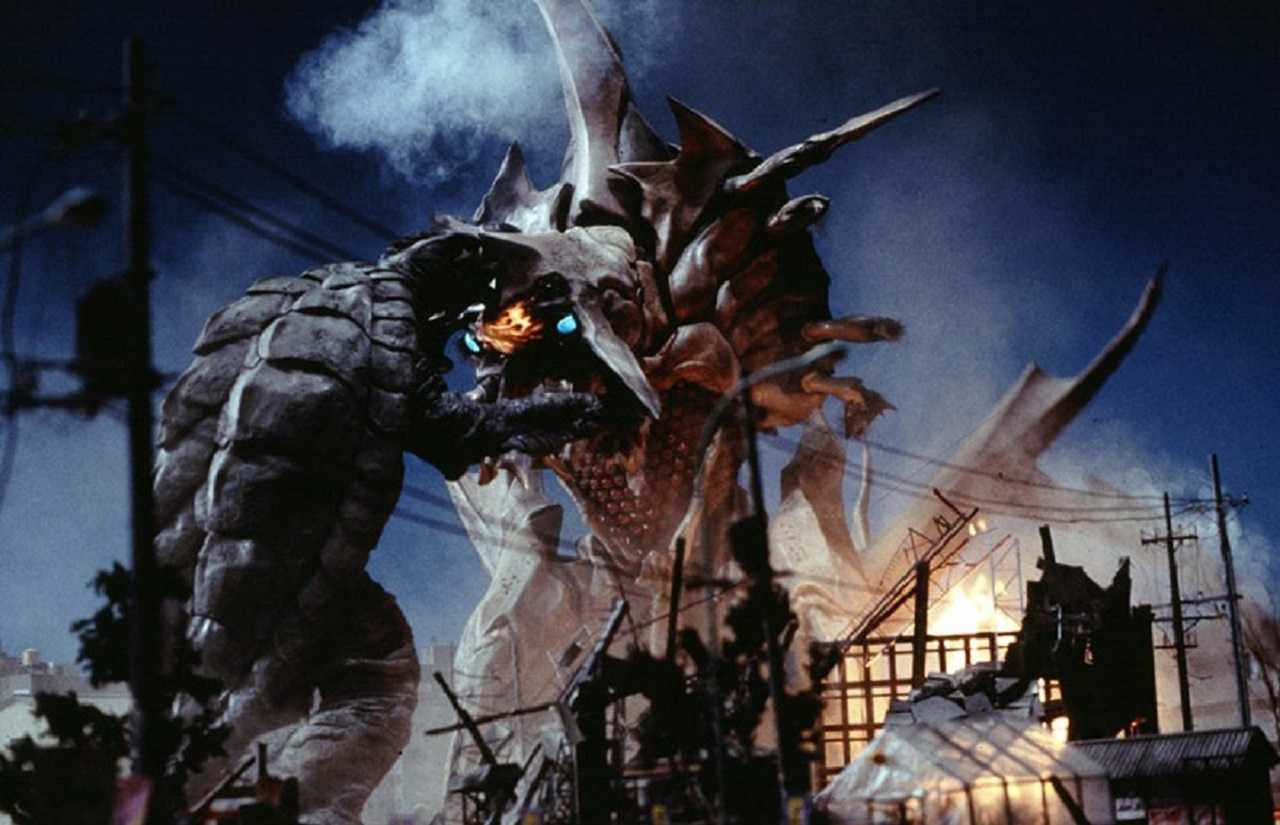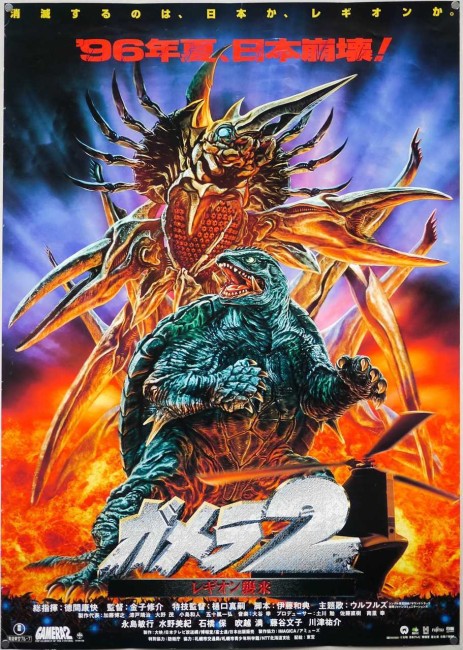(Gamera 2: Region Shurai)
Japan. 1996.
Crew
Director – Shusuke Kaneko, Screenplay – Kazunori Ito, Producers – Miyuki Nanri, Naoki Sato & Tsutomu Tsuchikawa, Photography – Junichi Tozawa, Music – Koh Otani, Special Effects – Shinji Higuchi, Production Design – Hajime Oikawa. Production Company – Daiei/NTV Network/Hakuhodo/Fujitsu/Nihon Shuppan.
Cast
Miki Mizuno (Midori Hinami), Toshiyuki Nagashima (Colonel Watarase), Mitsuru Fukikoshi (Obitsu), Tamaotsu Ishibashi (Hanatani), Ayako Fujitani (Asagi Kusanagi)
Plot
A meteorite lands in the mountainous area north of Sapporo. Soon after, alien bug creatures attack in the Sapporo City subway. A giant pod smashes up through the buildings and starts to change the air. Scientists believe it is an alien creature that is attracted by silicon and electromagnetic radiation. They name it Legion because the insects act as a hive mind. Gamera appears and battles Legion. Legion then hatches into an even more powerful form and rampages across the countryside.
Gamera is a Japanese monster that was created as a copy of Toho’s Godzilla by rival company Daiei. Beginning with Gammera the Invincible (1965), Gamera was put through seven cheap films, before Daiei’s financial collapse in the mid-1970s. (See below for listing of the other Gamera films). In the 1990s, director Shusuke Kaneko conducted a revival of the series with the sensational Gamera, The Guardian of the Universe (1995), which immediately set a new benchmark of effects in the Japanese monster movie. Kaneko next made Assault of Legion here and completed the trilogy with Gamera 3: Revenge of Iris (1999), which is one of the 2-3 best Japanese monster movies ever made. (For more detail see Japanese Monster Movies).
I watched Gamera 2: Assault of Legion after having seen both The Guardian of the Universe and Revenge of Iris and having been blown away by both. Assault of Legion is the least widely available of the three films. In finally tracking it down, I sat down to watch expecting more of what Shusuke Kaneko had conducted with the other two films – and came away disappointed.
Shusuke Kaneko follows the same approach he does in his other monster films – he takes some time in the build-up before he unveils the monster(s). On the minus side, nothing much happens during these scenes – Legion sends forth some bug creatures that kill people in a subway car and then creates a giant plant that sits atop a building not doing much except apparently changing the air. The human characters seem even more perfunctory and irrelevant to the special effects than they usually do in a Japanese monster movie.

The mass destruction scenes kick in somewhat with the arrival of Gamera, which perks things up. Mindedly, the film reaches the one-hour point with still not a great deal having happened. The film does finally get it together for a standard spectacular mass destruction ending – even so, it feels routine in comparison to the other modern Gamera or Godzilla entries. Gamera also gains the heretofore unmentioned ability to harness the energies of the Earth to make a revival after being downed by Legion.
Certainly, the full form of Legion is one of the more outlandish of all Japanese monsters. It has something akin to a scorpion body and an upright torso with a circular head that is surrounded by spikes that stand out in a halo, a long abdomen that has multiple tails waggling after it, and a long proboscis that opens up into a maw that uses its two jaws to fire energy bolts at people like a giant Van der Graaff accelerator.
The other Gamera films are:– Gammera the Invincible (1965), Gamera vs Barugon/War of the Monsters (1966), Gamera vs Gyaos/Return of the Giant Monsters (1967), Destroy All Planets (1968), Attack of the Monsters/Gamera vs Guiron (1969), Gamera vs Jiger/Gamera vs Monster X/Monsters Invade Expo 70 (1970), Gamera vs Zigra (1971) and Gamera: Super Monster (1980). Shusuke Kaneko’s other revival films are:- Gamera, The Guardian of the Universe (1995) and Gamera 3: Revenge of Iris (1999). There was also the subsequent Gamera the Brave (2006).
Shusuke Kaneko’s other genre films include The Cold episode of the H.P. Lovecraft anthology Necronomicon (1993), School Ghost Story 3 (1997), the spectacular pyrokinesis film Cross Fire/Pyrokinesis (2000), Godzilla Mothra and King Ghidorah: Giant Monsters All-Out Attack (2001), the fantasy musical Toast of Love (2002), the hit horrors of Death Note (2006) and Death Note: The Last Name (2006), Danger Dolls (2014) about an all-girl sf action team; and the time travel comedy Linking Love (2017).
Trailer here


